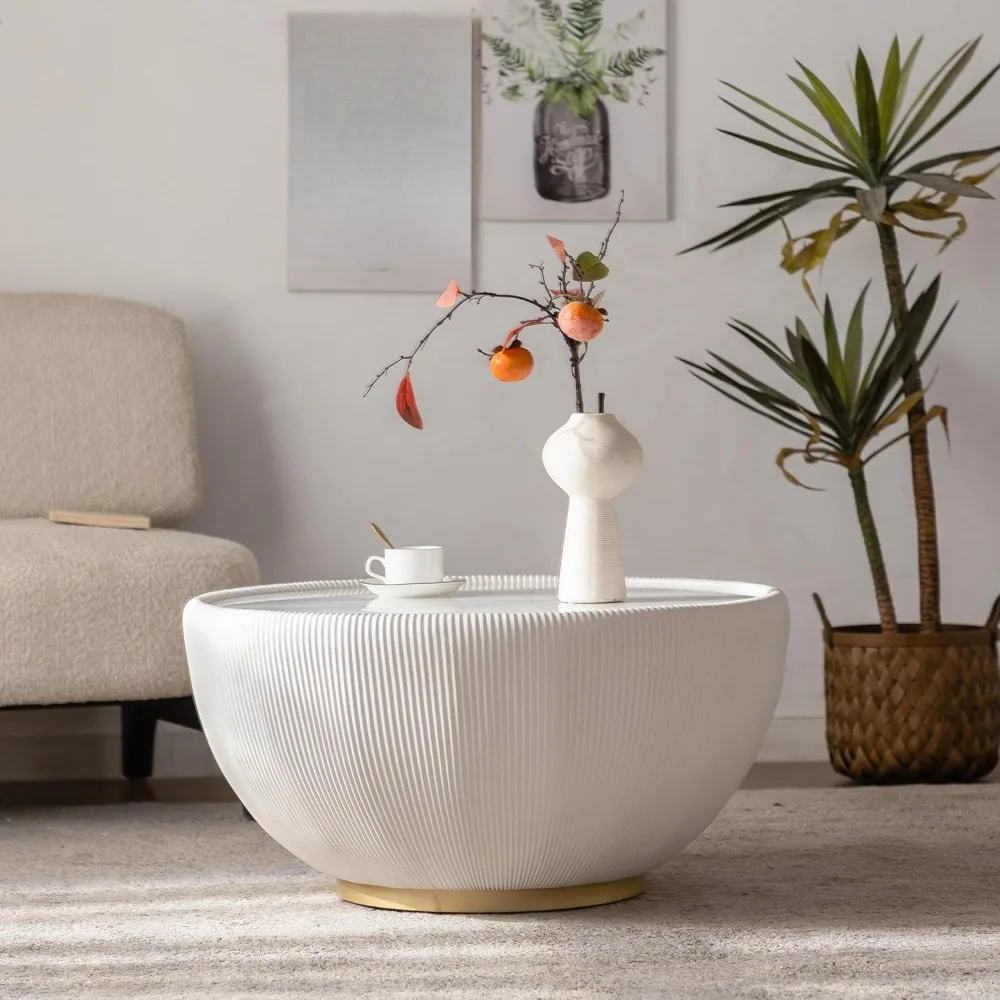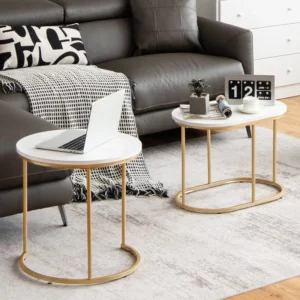Understanding the Perfect Blend: Form and Function in Mid-Century Design
Mid-century coffee tables stand apart through their distinctive features – clean, uncluttered lines, organic shapes that mirror natural forms, and high-quality materials that ensure longevity. Unlike many furniture styles that prioritize appearance over usefulness, mid-century modern design follows a clear philosophy: form follows function. This principle ensures that while these pieces look beautiful, they’re designed first and foremost to serve practical purposes.
Round shapes in mid-century design weren’t just aesthetic choices but intentional functional decisions. The absence of corners creates natural flow, saves space, and promotes safety – all while maintaining visual appeal. These circular tables demonstrate how intelligent black mid-century coffee tables combine artistic expression with everyday practicality.
The enduring popularity of these pieces isn’t merely about nostalgia. Designers like Isamu Noguchi and Eero Saarinen championed round table designs that continue to feel relevant decades later because they solve everyday problems while looking effortlessly stylish. Today’s mid-century modern round coffee tables continue this tradition of blending beauty with purpose.
In the following sections, we’ll explore the numerous practical benefits these timeless pieces bring to contemporary homes – beyond their undeniable visual charm.
Space Optimization: Creating Flow in Any Living Area
One of the most practical advantages of round mid-century coffee tables is their ability to maximize space efficiency, particularly in areas where square footage is at a premium. Unlike their rectangular counterparts, round tables create natural pathways for movement through living spaces. Without sharp corners jutting into walkways, people can navigate around the table more freely, requiring approximately 30% less clearance space.
This improved flow becomes especially valuable in apartment living or small living rooms where every inch matters. The circular silhouette creates an intuitive traffic pattern that guides movement around rather than through the space. The design benefits of round mid-century tables extend beyond mere convenience to fundamentally change how a room functions.
Round tables also affect spatial perception in fascinating ways. Their curved edges create an illusion of more space as they don’t visually divide a room into geometric sections. This perception trick works particularly well in open-concept spaces where defined zones need to flow together naturally.
The concept of “negative space” – the empty area around and between objects – is utilized more effectively with round tables. Their shape minimizes awkward corners and creates balanced negative space that contributes to a sense of openness. For those working with limited square footage, mid-century modern small coffee tables provide the perfect balance of function and space efficiency.
When arranging furniture, round tables offer unique flexibility. They can be positioned centrally without creating a boxy feeling or tucked partially under other furniture when not fully in use, an arrangement that rectangular tables simply cannot achieve comfortably.
Enhanced Safety: The Family-Friendly Advantage
The absence of sharp corners makes round mid-century coffee tables inherently safer for households of all types. This design feature significantly reduces the risk of injuries from accidental bumps or falls, a particular concern for homes with:
- Young children learning to walk
- Energetic pets that run through living spaces
- Elderly family members with balance concerns
- Anyone who moves through the space in low light
The smooth, continuous edge of a round table disperses impact force across a wider area rather than concentrating it at a sharp point. This difference can mean the difference between a minor bump and a painful injury requiring medical attention.
What makes round mid-century coffee tables family-friendly is that this safety doesn’t come at the expense of sophistication. Unlike obviously child-proofed furniture with padding or plastic covers, these tables offer natural safety through their fundamental design. The gentle curves and smooth transitions are original design elements, not safety modifications.
The ergonomic advantages extend beyond accident prevention. Rounded edges are more comfortable to lean against or reach across, creating a more physically pleasant experience during everyday use. This thoughtful design consideration exemplifies how mid-century philosophy integrates human comfort into visual design.
The Social Circle: Facilitating Connection and Interaction
Round coffee tables naturally foster social connection through their shape. Unlike rectangular tables that create a hierarchy with “head” positions, circular tables promote equality in conversation. Everyone seated around a round table has equal access to the surface and faces each other naturally, encouraging eye contact and inclusive discussion.
The psychological impact of circular arrangements runs surprisingly deep. Research in spatial psychology suggests that round seating configurations increase people’s perception of belonging and encourage more democratic participation in conversations. This makes round tables particularly valuable for game nights, casual gatherings, or intimate conversations.
The versatility of round tables adapts to various social scenarios. They accommodate different numbers of people more gracefully than rectangular tables, where odd numbers can leave awkward empty spaces. For additional flexibility, mid-century modern nesting coffee tables can be expanded for larger gatherings or condensed for everyday use.
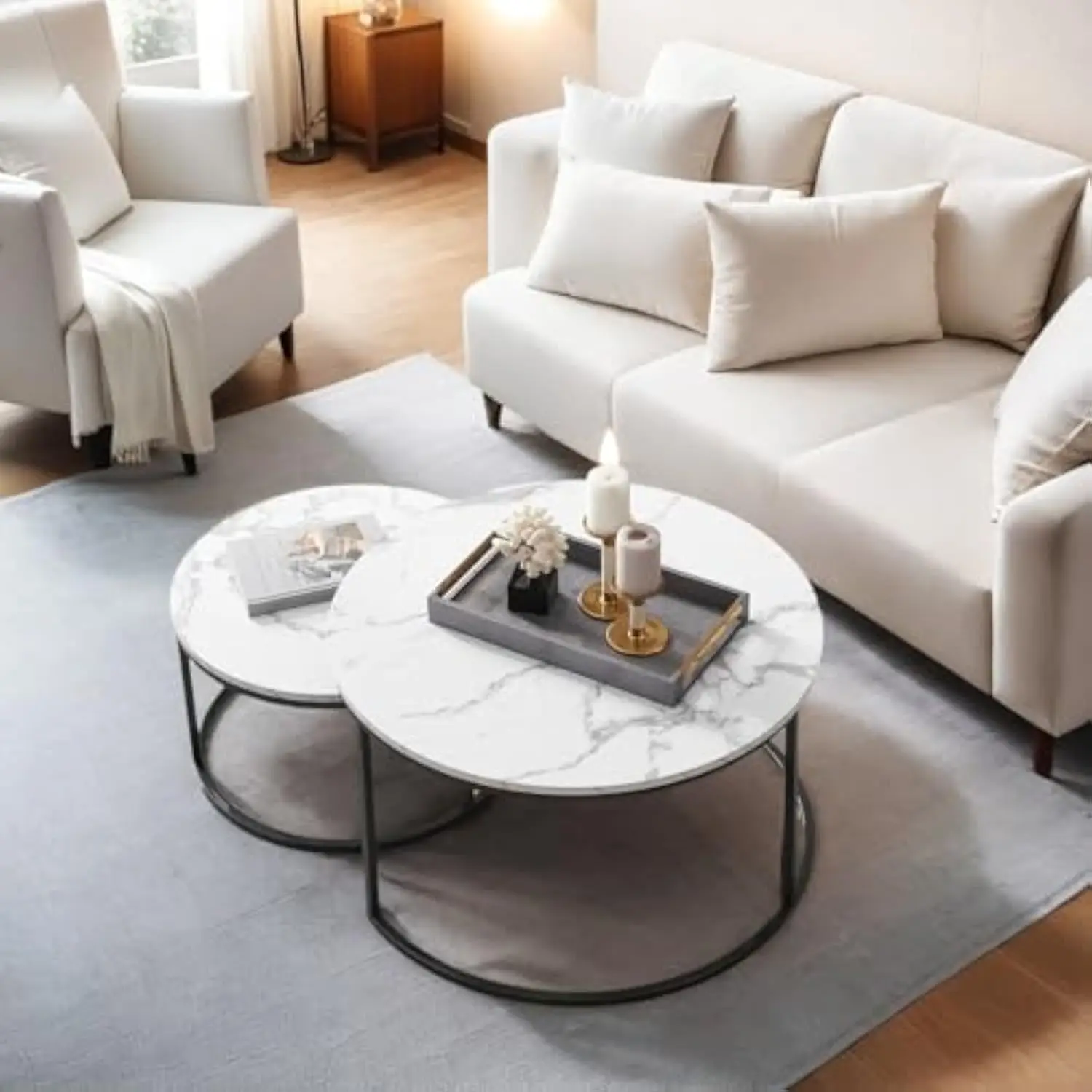
Round tables also create a natural focal point that draws people together without creating barriers. The absence of corners means there are no “bad seats” where someone might feel excluded from the group. This subtle but important feature makes round tables particularly valuable in spaces designed for socializing and building connections.
Clever Storage Solutions: Mid-Century Organization
Mid-century design excels at integrating storage solutions seamlessly into beautiful furniture. Round coffee tables from this era often feature ingenious storage options that maintain clean lines while providing practical organization. These features help keep living spaces tidy without requiring additional storage furniture.
Common storage variations in round mid-century coffee tables include:
- Hidden compartments beneath lift-up tops for remote controls and magazines
- Discrete drawers that blend into the table’s silhouette
- Open shelving beneath the tabletop for books or decorative items
- Two-tier designs with an additional surface for display or storage
- Nesting designs that provide adjustable surface area as needed
The beauty of these storage features is how they maintain the table’s aesthetic integrity. Unlike obvious utility furniture, the storage elements in mid-century modern lift-top coffee tables feel like natural extensions of the design rather than practical afterthoughts.
These tables accommodate a wide range of storage needs. Remote controls, magazines, board games, craft supplies, and other living room essentials find natural homes within these cleverly designed pieces. The integration of storage also provides a way to keep frequently used items within reach but out of sight, supporting a clutter-free environment.
For many urban dwellers or those in smaller homes, this dual-purpose functionality makes round mid-century coffee tables especially valuable. The ability to reduce the number of separate storage pieces needed in a room helps maintain open, uncluttered spaces.
Versatility in Design: Adapting to Various Living Spaces
Round mid-century coffee tables demonstrate remarkable adaptability across different interior styles and furniture arrangements. Their balanced proportions and clean designs allow them to complement traditional, contemporary, and eclectic décor with equal success.
One of their greatest strengths is creating visual balance in rooms dominated by linear furniture. Most sofas, entertainment units, and bookcases feature straight lines and right angles. A round coffee table provides a welcome counterpoint, softening the overall look and preventing the space from feeling rigid or boxy. This principle of contrast makes decorating black mid-century coffee tables particularly effective in creating visual interest.
Round tables work exceptionally well with various seating arrangements:
- With sectional sofas, they soften the angular corner junction
- In conversation areas with multiple chairs, they provide equal access from all seats
- With facing sofas, they bridge the gap without creating territorial divisions
- In asymmetrical layouts, they create a balanced focal point
Their adaptability extends to functioning as either statement pieces or supporting elements. A distinctive round table with unique materials or design features can serve as a room’s centerpiece, while simpler designs blend harmoniously into existing décor schemes. This chameleon-like quality makes round tables suitable for nearly any design vision.
The versatility of round tables also extends to their positioning flexibility. Unlike rectangular tables that often look best aligned parallel to sofas, round tables can be placed with more freedom while still looking intentional and balanced.
Mid-Century Modern Solid Wood Coffee Tables, Mid-Century Modern Teak Coffee Tables
$879.95 Select options This product has multiple variants. The options may be chosen on the product pageMid-Century Modern Danish Coffee Tables, Mid-Century Modern Oval Coffee Tables, Mid-Century Modern Solid Wood Coffee Tables
$390.05 Select options This product has multiple variants. The options may be chosen on the product pageMid-Century Modern Glass Top Coffee Tables, Mid-Century Modern Glass Top Side & End Tables
$460.58 Select options This product has multiple variants. The options may be chosen on the product pageMid-Century Modern Glass Top Coffee Tables, Mid-Century Modern Vintage Coffee Tables, Mid-Century Modern Vintage Side & End Tables
$725.36 Select options This product has multiple variants. The options may be chosen on the product pageMid-Century Modern Lift Top Coffee Tables, Mid-Century Modern Square Coffee Tables
$454.73 Select options This product has multiple variants. The options may be chosen on the product pageMid-Century Modern Nesting Coffee Tables, Mid-Century Modern Nesting Table Sets
$361.45 Select options This product has multiple variants. The options may be chosen on the product page
Practical Surface Utility: Maximizing Usable Area
While round tables might seem to offer less surface area than rectangular ones of similar dimensions, their practical usability often exceeds expectations. The distribution of space on a round surface offers distinct advantages for everyday use.
A 36-inch diameter round table provides approximately 7 square feet of usable surface. While this is technically less than a 30×48-inch rectangular table offering 10 square feet, the round table’s usability is enhanced by several factors. Without corners, every inch of the surface remains easily accessible from any position around the table. This universal accessibility makes the actual functional space more efficient.
Many mid-century modern glass top coffee tables feature subtle raised edges or borders that prevent items from sliding off – a thoughtful detail that increases practical functionality. These design elements allow for the placement of items closer to the edge without risk of accidents.
Surface materials significantly impact functionality. Common options include:
- Wood surfaces provide warmth and natural beauty but require protection from moisture and heat
- Glass tops offer heat resistance and easy cleaning but show fingerprints more readily
- Composite materials combine durability with design flexibility
- Stone or marble tops provide exceptional durability with distinctive appearance
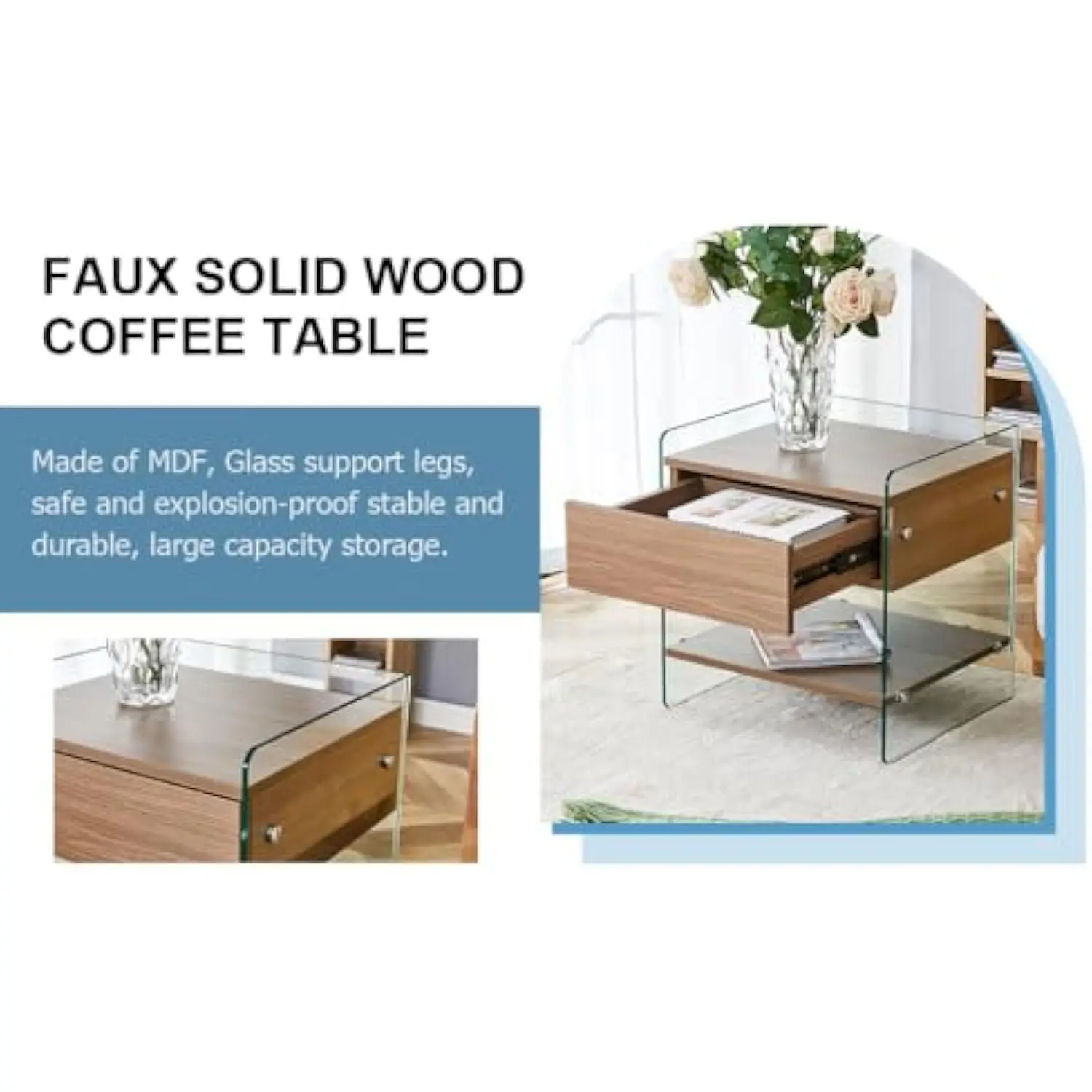
The height of round coffee tables also contributes to their utility. Standard heights between 16-18 inches work well for everyday use while allowing for comfortable leg clearance when seated on standard sofas. Some designs feature adjustable heights or nesting options that adapt to different activities – from casual snacking to board game sessions.
Material Quality and Durability: The Mid-Century Difference
The exceptional durability of authentic mid-century round coffee tables stems from a combination of quality materials and construction techniques that have stood the test of time. These tables weren’t designed as temporary furnishings but as lasting investments – a philosophy evident in their longevity.
Common materials found in quality mid-century round coffee tables include:
- Teak: Naturally oil-rich wood that resists moisture and remains stable with minimal maintenance
- Walnut: Dense hardwood with rich coloring that develops a distinctive patina over time
- Oak: Extremely durable with prominent grain patterns that add character
- Rosewood: Exotic wood prized for deep coloration and natural luster
- Glass: Often tempered for safety and durability
- Metal accents: Usually brass, chrome, or powder-coated steel for contrast and structural support
What makes these materials special is how they age. Unlike modern particleboard furniture that deteriorates with time, solid wood mid-century pieces often improve in appearance. The features of black mid-century coffee tables showcase how these pieces develop character through decades of use.
Traditional joinery methods contribute significantly to durability. Dovetail joints, mortise and tenon connections, and other woodworking techniques create structural integrity that withstands daily use. Many pieces feature reinforced stress points and thoughtful engineering that prevents common furniture failures.
The sustainability aspect of well-crafted furniture deserves mention. A quality mid-century table can remain functional for generations, representing a more environmentally conscious approach to furnishing than disposable contemporary alternatives. This longevity makes them both practical investments and responsible choices.
Round vs. Rectangular: When Circular Is the Superior Choice
When deciding between round and rectangular coffee tables, certain scenarios clearly favor the circular option. Understanding these comparative advantages helps make informed decisions for specific spaces and needs.
| Feature | Round Tables | Rectangular Tables | When Round Excels |
|---|---|---|---|
| Traffic Flow | Smooth, continuous pathways | Requires more clearance around corners | Small spaces, high-traffic areas |
| Child Safety | No sharp corners | Potential injury points | Homes with young children |
| Social Dynamics | Equal access, democratic | Creates hierarchy with head/foot positions | Conversation-focused areas |
| Visual Weight | Lighter appearance, creates space | More substantial presence, divides space | Making rooms feel larger |
| Furniture Pairing | Softens angular furniture | Echoes linear furniture shapes | With sectionals or angular seating |
Round tables prove particularly advantageous in rooms with specific characteristics:
- Smaller spaces where traffic flow is critical
- Rooms with curved architectural features that echo circular shapes
- Open floor plans where defined but flowing spaces are desired
- Areas where furniture is frequently rearranged for different activities
For those comparing options, large rectangular and round mid-century tables offer different functional advantages depending on specific needs. While rectangular tables excel for certain uses like accommodating many items in an organized grid, round tables offer unique benefits that make them superior choices in many living situations.
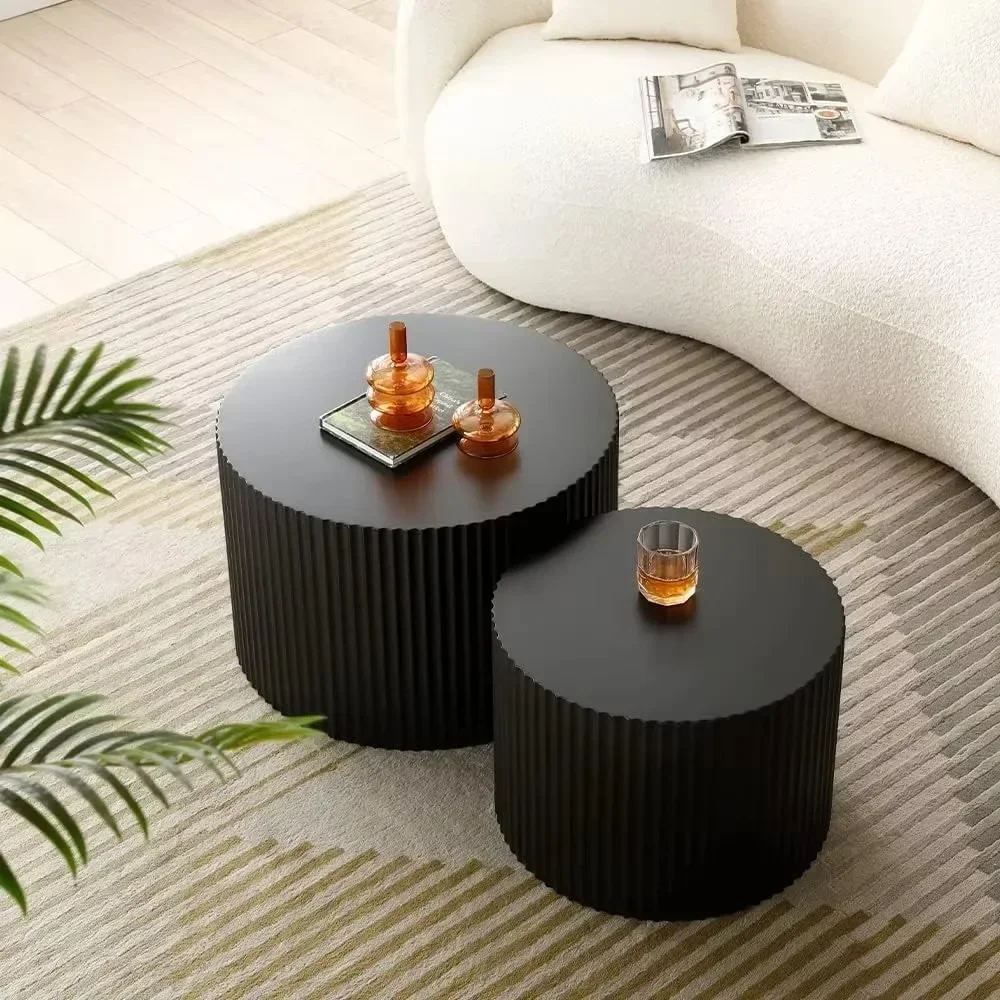
The complementary furniture that works particularly well with round tables includes curved sofas, swivel chairs, ottomans, and poufs. These pieces create cohesive conversation areas that maximize the round table’s natural tendency to foster interaction.
Selecting Your Ideal Round Mid-Century Coffee Table
Finding the perfect round coffee table requires consideration of several key factors that affect both functionality and visual harmony. By following these guidelines, you can select a piece that enhances your space both practically and aesthetically.
Proper sizing creates balanced proportions with existing furniture. As a general rule, a coffee table should measure approximately two-thirds the length of your sofa. For round tables, this translates to diameter:
- For standard 84-inch sofas: 30-36 inch diameter table
- For apartment-sized 72-inch sofas: 28-32 inch diameter table
- For compact 60-inch loveseats: 24-28 inch diameter table
Height considerations are equally important for comfort and function. The ideal coffee table sits 1-2 inches below the seat height of your sofa, typically between 16-18 inches tall. This relationship ensures comfortable reach while avoiding awkward proportions.
Material selection should reflect your lifestyle needs. The black mid-century coffee table design choices available today offer various practical benefits:
- Solid hardwoods provide durability but require protection from moisture
- Glass tops resist stains and heat but show fingerprints and dust
- Veneered surfaces offer beautiful grain patterns at a lower weight
- Metal components add structural strength and visual interest
Consider your household’s specific needs when selecting features. Homes with small children might prioritize rounded edges and stable bases, while frequent entertainers might value expandable options or additional surface area through nesting designs.
The distance between your coffee table and seating should allow for comfortable movement – typically 16-18 inches provides enough space for leg room while keeping the surface within easy reach.
FAQ: Common Questions About Round Mid-Century Coffee Tables
What size round coffee table works best for different seating arrangements?
For conversation areas with multiple seats, a 36-42 inch diameter table ensures everyone can reach the surface. For smaller arrangements with a single sofa, 28-36 inch diameter tables provide sufficient surface without overwhelming the space. The key is maintaining 16-18 inches of clearance between the table edge and seating for comfortable leg room.
Are round coffee tables more stable than rectangular ones?
Round tables with properly designed bases often provide better stability than rectangular tables. Central pedestal bases distribute weight evenly, preventing tipping that can occur with four-legged rectangular designs. However, stability depends primarily on construction quality rather than shape alone.
How do I match a round mid-century coffee table with my existing furniture?
Focus on complementary elements rather than exact matching. Round tables pair naturally with angular furniture by creating contrast. Look for shared design elements like wood tones, leg styles, or material finishes that create cohesion without requiring identical pieces.
What’s the ideal height for a round coffee table relative to my sofa?
The table surface should sit 1-2 inches below your sofa seat height, typically 16-18 inches from the floor. This height allows comfortable reach while seated and maintains proper visual proportions.
How do I maintain the wood finish on a mid-century coffee table?
Regular dusting with a soft cloth prevents surface scratching. Apply furniture polish appropriate for your specific finish type every 3-6 months. For mid-century modern solid wood coffee tables, immediately wipe up any moisture and use coasters to prevent water rings and heat damage.
Can round coffee tables provide enough surface area for my needs?
A 36-inch round table provides approximately 7 square feet of usable surface – ample space for drinks, books, and decorative items. The shape eliminates unreachable corners, making the available surface more functional than it might appear on paper.
How do nesting or tiered round coffee tables enhance functionality?
These versatile designs provide adjustable surface area that adapts to changing needs. Nesting tables can be separated to serve multiple seating areas during gatherings or combined to minimize footprint when not in use. Tiered designs effectively double available surface area while maintaining a compact footprint.

